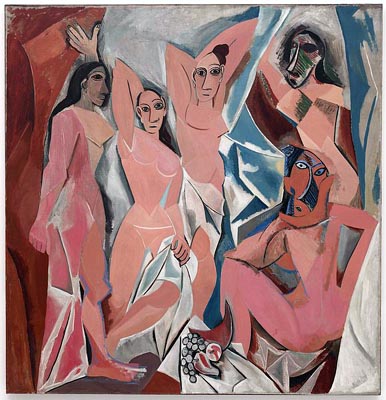 |
| Picasso in 1962 (Wikipedia) |
Note: "You're no Picasso" we might tell a dabbler. Pablo Picasso's surname has become a byword for "artist," and the range and quality of his work shows us why.
Get Ready: At what age did you discover your passion?
Thirty years younger than the scientist Santiago Ramón y Cajal (see Lesson #04-015), the Spanish artist Pablo Picasso (1881-1973) far surpassed him in fame.
Pablo Ruiz y Picasso was the first son of an art professor, who also ran a local museum. His mother reported that baby Pablo's first words were "piz, piz"--a shortened "baby" form of lapiz, the Spanish word for "pencil."
He showed great talent from an early age. At age seven, he began training with his father. One apocryphal story says that on observing his 13-year-old son's superior skills, the father vowed to give up painting. (But works by the father are known from after this date!) At around that age, Pablo entered an art academy, and at age 16, he began studying at the Royal Academy of San Fernando in Madrid. However, he preferred observing great works in the renowned Museo del Prado--by artists like Velázquez, Goya, and especially El Greco--to the stuffy environment of formal study.
Picasso's early work is often divided into five (or more) periods: early work (before 1900), traditional in style; the Blue Period (1901-1904), with heavy use of blues and greens, and serious subjects; the Rose Period (1904-1906), more cheerful, with brighter colors; the African-influenced Period (1907-1909), figures with faces like African masks; and Cubism (1909-1919), developed with the French artist Georges Braque, breaking objects into their parts.
His later work is less-easily defined. For a time, he worked in a more classical, realistic style; in the 1920s the Surrealists claimed he was one of them. He continued to produce in a variety of styles through the Second World War, the 50s and 60s, and on until his death.
From 1935 to 1959, Picasso wrote more than 300 poems, as well as two full-length plays (though these were never meant to be acted, only read aloud).
 |
| Guernica (Wikipedia) |
Two of Picasso's paintings stand out among the many others. Guernica depicts a bombing raid on a small Spanish village during the Spanish Civil War. It is meant to show the horrors of war. The second is Les Demoiselles d'Avignon, showing a group of French prostitutes.
 |
| Les Demoiselles d'Avignon (Wikipedia) |
Picasso achieved a level of wealth and fame that most artists can only dream of. He is rightly considered one of the most important artists of the 20th century.
--------Read more: https://en.wikipedia.org/wiki/Pablo_Picasso
Practice: Match the term to its definition below:
- academy
- apocryphal
- depicts
- prostitutes
- raid
- renowned
- rightly
- stuffy
- surpassed
- vowed
- too serious, boring
- shows
- an attack
- well-known; famous
- people who have sex for money
- a formal training school
- solemnly promised
- believed by many, but probably not true
- went further than
- properly; truly
Answers are in the first comment below.
Submitted to the Shenzhen Daily for May 5, 2015


Answers to the Practice: 1. f; 2. h; 3. b; 4. e; 5. c; 6. d; 7. j; 8. a; 9. i; 10. g
ReplyDelete